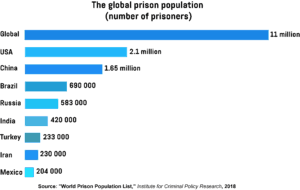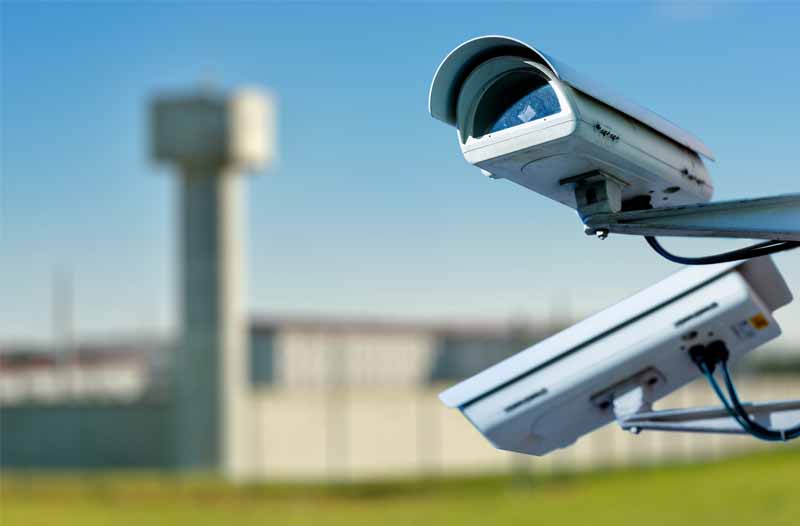- HM Prison Wymott is using telecare technology to support aging prisoners
- The Les Nicolles prison in Guernsey introduced anti-drone technology
- A prison where inmates can move around freely
- Hong Kong is developing a smart prison system
- The Singapore Prison Service is using technology to make its prisons smarter
- Using technology to create a safer prison environment
According to the most recent World Prison Population List, there are currently more than 11 million people behind bars throughout the world. Unsurprisingly, the United States has the world’s largest prison population with 2.1 million, followed by China with 1.65 million, Brazil with 690,000, Russia with 583,000, and India with 420,000. Overall, the world’s prison population total has increased by 24 per cent since the year 2000. The only continent where this trend has been reversed is Europe, which has seen its prison population decrease by 22 per cent during the same period.

With so many people incarcerated, keeping everyone within the prison system safe is an incredibly demanding task. Correctional officers need to constantly keep an eye on a wide variety of things that can potentially endanger the lives of both inmates and staff. Violent fights among prisoners are quite frequent, while drug smuggling is rampant and can sometimes lead to overdoses. Some prisoners will even attempt to harm themselves.
Furthermore, just like the rest of the population is getting older, the same applies to those behind bars as well. And this aging prison population presents a whole new set of demands for prison authorities, including a greater need for social care. As a result, more and more prisons around the world are exploring the possibility of employing smart technologies such as sensors, artificial intelligence, and data analytics to respond adequately to these new demands and challenges.
HM Prison Wymott is using telecare technology to support aging prisoners
The issue of the aging prison population is especially pronounced in England and Wales, where prisoners over 50 years of age account for 17 per cent of the population. The prisons and probation service estimates that this figure will continue to grow in the future, from 13,376 people in 2017 to 14,800 in 2021. Prisoners over 50 often suffer from a variety of moderate to severe health conditions, with as much as 90 per cent of them having at least one, while more than half have three or more.

Prisoners over 50 make up one third of the population in HM Prison Wymott, located near Leyland in Lancashire. To address this issue and provide aging prisoners with the care they need, this correctional facility has decided to install telecare, a support system that allows automatic and remote monitoring of users with the help of sensor-equipped bracelets and pendants. While 1.7 million people in the UK use telecare today, HMP Wymott is the first facility of its type to join the list.
Once social workers identified 11 prisoners who were at high risk of falls, seizures, heart attacks, or strokes, they were supplied with bed occupancy sensors and a wrist-worn bracelet. The bed sensors are triggered if prisoners leave their beds for more than 10 minutes during the night, while the bracelets send an alert if they detect a fall. The bracelets also feature a button prisoners can press in case they need help. All alerts are sent to a call centre, which then calls the prison’s operations room and informs the staff which sensor was triggered so they can investigate further. For instance, in 2017, one of the prisoners fell out of bed after having a stroke. Thanks to the sensors, prison staff was able to react in time and save his life.
In addition to saving prisoners’ lives, the system is also reducing costs by cutting the number of hospital visits and decreasing the number of staff needed to care for prisoners. According to Laura Hudson, a social worker at Lancashire county council, telecare has saved the council $227,700 in one year for six prisoners, so the council now working on introducing the system to three more prisons in the near future.
The Les Nicolles prison in Guernsey introduced anti-drone technology
The use of drones to smuggle in drugs, weapons, and other contraband has become one of the biggest security challenges for many prisons in recent years. To combat this issue, Les Nicolles prison on Guernsey has installed an innovative anti-drone system called SkyFence, which creates a 600-metre virtual shield around the facility that prevents drones from entering the prison’s airspace. Developed in a collaboration between Drone Defence and Eclipse Digital Solutions, SkyFence detects any remote-controlled drones that attempt to cross the perimeter and forces them to retreat by blocking their frequency and control protocols using sensors called ‘disruptors’. It’s the first system of its kind to be installed in a prison environment, and it’s part of a $2.25 million overhaul of the prison’s security system, which will also upgrade its surveillance cameras, lighting, fencing, and alarms.
“It disrupts the control network between the flyer and the drone. The drone then activates return to home mode and it will then fly back to the position where it had signal with its flyer,” explains Drone Defence’s founder and CEO, Richard Gill. “Someone described it as the final piece in a prison’s security puzzle. I think it could have a significant worldwide impact.” Previously, prisons used to cover windows and outside spaces with large nets or even used eagles to try to prevent drones from entering their airspace, but those solutions haven’t been particularly effective. SkyFence, on the other hand, has proven 100 per cent effective since it was introduced in Les Nicolles prison, not letting a single drone penetrate the perimeter. The system can easily be integrated into existing security systems, it’s safe to use, and doesn’t affect the prison’s functions or communications infrastructure. It also allows guards to leave drone monitoring to technology and focus on more important tasks within the prison. Following a successful six-month trial in Guernsey, the UK government is now considering installing the system in other prisons across the country.
A prison where inmates can move around freely
Opened in September 2016, the Judicial Complex (JCZ) in the Netherlands is one of the most technologically advanced correctional institutions in the world. It spreads over 68,000 square metres and consists of three separate sections: a prison section, the Penitentiary Psychiatric Centre, and a section that contains support services. It has 667 cells that can accommodate up to 1000 prisoners. The most impressive feature of the new prison is its innovative security system based on Sphere Security Management, developed by a company called IOLAN.
“A diverse range of sub-systems are linked to the system, including fire detection, access control, camera monitoring, intercom, a mobile alarm system, together with a variety of actuators and sensors, such as door locks, alarm pushbuttons, lighting and even showers,” says Gerard Verbiest, the company’s managing director. “Sphere ensures that all security processes are carried out automatically, presenting all of the information and processing procedures required in a simple manner, in order to ensure that verification and management can be carried out in the most efficient way possible. The result is a system that is characterised by a high degree of integration, the like of which has not yet been seen in any custodial institution.”
Each inmate in JCZ is given an RFID card that allows them to operate facilities in their own cells, including the lighting, equipment, and the shower. The card also enables them to open their own cell doors and move around freely within the institution, but only at specific times and using predetermined routes. Inmates can also use the card to make telephone calls, schedule visits, and submit retail orders. “This combination of advanced systems provides inmates with greater insight, coupled with more tasks and freedom, thereby reducing the workload of staff at PC Zaanstad, reducing the number of administrative actions that are required and preventing errors,” adds Verbiest.

Hong Kong is developing a smart prison system
Hong Kong authorities now want to take this idea one step further and make all of their correctional institutions smart. Hong Kong’s Correctional Services Department (CSD) recently unveiled plans to develop a smart prison system that will employ tracking wristbands, drug-detecting robots, and video monitoring systems to keep inmates safe. “The Correctional Services Department strives to enhance efficiency of custodial operations and security of correctional institutions through the application of innovation and technology, while protecting the safety of officers and persons in custody,” says the Commissioner of Correctional Services Danny Woo Ying-ming. The technology will first be tested on a smaller scale, starting with several select facilities, before expanding it across the country. Provided everything goes well, of course.
A robotic arm, which will be tested at the Lai Chi Kok Reception Centre, will take over the unpleasant task of checking inmates’ faeces for drugs and other contraband. Until now, correctional officers had to inspect the faecal matter manually using wooden sticks. The robot will automatically push the faeces from a container to a drain and break the sample down by spraying it with water, revealing any smuggled items in the process.
Wristbands will enable staff to monitor prisoners’ whereabouts and their heart rates at all times, sending an alert if they detect something unusual, such as an irregular pulse. The staff will also be alerted if the prisoners attempt to remove the wristband. The officials hope that the wristbands, which will be tested at the Lo Wu Correctional Institution, will help them reduce the number of suicides. Finally, a video surveillance system will be installed in four dormitories and a toilet at the Pik Uk Prison. It consists of 12 cameras and will be able to detect abnormal behaviour, such as prisoners collapsing, trying to hurt themselves, or fighting.
While these technologies will certainly make correctional officers’ jobs easier and maybe even save inmates’ lives, they also raise numerous privacy concerns. Ng Chiu-kok, a senior superintendent at the Pik Uk Prison, claims that the footage from the toilets would be obscured to protect inmates’ privacy, but that wasn’t enough to ease the concerns. “How they will use and store the information, whether it can be abused, are sensitive issues,” says Shiu Ka-chun, a social welfare sector lawmaker. “They need to accurately state which data the wristband records.”
The Singapore Prison Service is using technology to make its prisons smarter
Prison facilities in Singapore are also increasingly turning to digital platforms and technologies to keep prisoners safe and help them reintegrate into society. The Singapore Prison Service (SPS) is now using CCTV and the Command, Control, Communication, Computer and Intelligence Management System (C4i) to maintain order and discipline in its housing units. By combining full digital CCTV coverage and critical data gathered by the C4i system, officers can switch their focus from routine guarding duties to inmate engagement and other more important tasks.
Intelligence-Driven Dynamic Security (IDDS) is another key element of Singapore’s prison environment. It helps SPS improve its surveillance systems and risk management capabilities by using data analytics to provide valuable information that allows officers on the ground to make better informed decisions. Furthermore, officers can use the Prison Operations & Rehabilitation System (PORTS) II mobile tablet devices to gain access to the information gathered through CCTV surveillance at any time.
However, guards aren’t the only ones who benefit from technology in Singapore’s prisons. Thanks to the Digitalisation of Inmate Rehabilitation & Corrections Tool (DIRECT) project, each inmate is assigned a tablet that allows them to send and receive e-letters, as well as access e-books, online resources, and motivational podcasts. This is meant to help them better reintegrate into society once they’re released and improve their chances of getting a job. Tablets serve another important purpose in that they help the staff better manage inmates by gathering information about their behaviour.
Using technology to create a safer prison environment
The first things that come to most people’s minds when they think about prisons are large walls and small cells. However, while the walls and cells can prevent people from breaking out, physical barriers alone aren’t enough to create a secure environment for both inmates and staff. Frequent fights, drug overdoses, and self-harming are just some of the things correctional officers need to keep an eye on at all times. That’s why prisons around the world are increasingly turning to technology to ensure the safety of everyone within the prison system. As technologies such as telecare support systems, inmate tracking wristbands, drug-detecting robots, and anti-drone systems make their way into the prison system, it will be important to balance the need for security with the prisoners’ right to privacy, what little they have left of it.
Share via:


